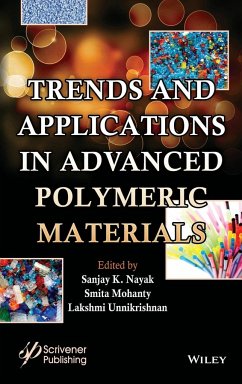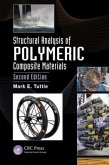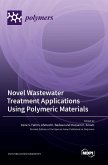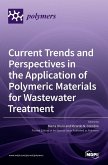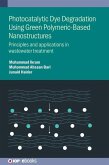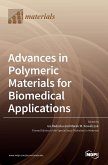Trends and Applications in Advanced Polymeric Materials
Herausgeber: Nayak, Sanjay K; Unnikrishnan, Lakshmi; Mohanty, Smita
Trends and Applications in Advanced Polymeric Materials
Herausgeber: Nayak, Sanjay K; Unnikrishnan, Lakshmi; Mohanty, Smita
- Gebundenes Buch
- Merkliste
- Auf die Merkliste
- Bewerten Bewerten
- Teilen
- Produkt teilen
- Produkterinnerung
- Produkterinnerung
This comprehensive compilation of contemporary research initiatives in polymer science & technology details the advancement in the fields of coatings, sensors, energy harvesting and gas transport. Polymers are the most versatile material and used in all industrial sectors because of their light weight, ease of processing and manufacturing, the ability to mold into intricate shapes, and its cost-effectiveness. They can easily be filled with a range of reinforcing agents like fibers, particulates, flakes and spheres in micro/nano sizes and compete with conventional materials in terms of…mehr
Andere Kunden interessierten sich auch für
![Structural Analysis of Polymeric Composite Materials Structural Analysis of Polymeric Composite Materials]() Mark E TuttleStructural Analysis of Polymeric Composite Materials265,99 €
Mark E TuttleStructural Analysis of Polymeric Composite Materials265,99 €![Novel Wastewater Treatment Applications Using Polymeric Materials Novel Wastewater Treatment Applications Using Polymeric Materials]() Novel Wastewater Treatment Applications Using Polymeric Materials111,99 €
Novel Wastewater Treatment Applications Using Polymeric Materials111,99 €![Current Trends and Perspectives in the Application of Polymeric Materials for Wastewater Treatment Current Trends and Perspectives in the Application of Polymeric Materials for Wastewater Treatment]() Current Trends and Perspectives in the Application of Polymeric Materials for Wastewater Treatment74,99 €
Current Trends and Perspectives in the Application of Polymeric Materials for Wastewater Treatment74,99 €![Photocatalytic Dye Degradation Using Green Polymeric-Based Nanostructures Photocatalytic Dye Degradation Using Green Polymeric-Based Nanostructures]() Muhammad IkramPhotocatalytic Dye Degradation Using Green Polymeric-Based Nanostructures207,99 €
Muhammad IkramPhotocatalytic Dye Degradation Using Green Polymeric-Based Nanostructures207,99 €![Polymers and Polymeric Composites Polymers and Polymeric Composites]() Polymers and Polymeric Composites182,99 €
Polymers and Polymeric Composites182,99 €![Advances in Polymeric Materials for Biomedical Applications Advances in Polymeric Materials for Biomedical Applications]() Advances in Polymeric Materials for Biomedical Applications57,99 €
Advances in Polymeric Materials for Biomedical Applications57,99 €![Advanced Healthcare Materials Advanced Healthcare Materials]() Advanced Healthcare Materials223,99 €
Advanced Healthcare Materials223,99 €-
-
-
This comprehensive compilation of contemporary research initiatives in polymer science & technology details the advancement in the fields of coatings, sensors, energy harvesting and gas transport. Polymers are the most versatile material and used in all industrial sectors because of their light weight, ease of processing and manufacturing, the ability to mold into intricate shapes, and its cost-effectiveness. They can easily be filled with a range of reinforcing agents like fibers, particulates, flakes and spheres in micro/nano sizes and compete with conventional materials in terms of performance, properties and durability. Polymers continue to be discovered and the demand for them is increasing. The book comprises a series of chapters outlining recent developments in various high performance applications of Advanced Polymeric Materials. The topics covered encompass specialized applications of polymeric matrices, their blends, composites and nanocomposites pertaining to smart & high performance coatings, high barrier packaging, solar energy harvesting, power generation using polymers, polymer sensors, conducting polymers, gas transport membranes and smart drug delivery systems. Thus, the theme of the book embraces all the latest innovations and future applications of polymers and related materials. What is novel about this book is that it delineates the applications from a research point of view through descriptions highlighting specific developmental criteria. Audience The book serves as a reference for all those industry polymer scientists and academic researchers required or interested in updating themselves on recent innovations. It will be exceedingly useful for engineers and students as the book acts as a practical guide for forward-looking research. Industrialists and entrepreneurs will also benefit by understanding the industrially viable technology from the novel techniques presented in the book.
Hinweis: Dieser Artikel kann nur an eine deutsche Lieferadresse ausgeliefert werden.
Hinweis: Dieser Artikel kann nur an eine deutsche Lieferadresse ausgeliefert werden.
Produktdetails
- Produktdetails
- Verlag: Wiley
- Seitenzahl: 330
- Erscheinungstermin: 6. November 2017
- Englisch
- Abmessung: 235mm x 157mm x 22mm
- Gewicht: 632g
- ISBN-13: 9781119363637
- ISBN-10: 1119363632
- Artikelnr.: 47551757
- Herstellerkennzeichnung
- Libri GmbH
- Europaallee 1
- 36244 Bad Hersfeld
- gpsr@libri.de
- Verlag: Wiley
- Seitenzahl: 330
- Erscheinungstermin: 6. November 2017
- Englisch
- Abmessung: 235mm x 157mm x 22mm
- Gewicht: 632g
- ISBN-13: 9781119363637
- ISBN-10: 1119363632
- Artikelnr.: 47551757
- Herstellerkennzeichnung
- Libri GmbH
- Europaallee 1
- 36244 Bad Hersfeld
- gpsr@libri.de
S. K. Nayak holds the position of Director General, Central Institute of Plastics Engineering & Technology (CIPET) as well as Prof. & Chair of R&D wings of CIPET. He is an active researcher in the field of polymer science & technology and has authored several textbooks on novel technological developments and is the Editor-in-Chief of International Journal of Plastics Technology (IJPT). Smita Mohanty is the Senior Scientist and In-charge of the Laboratory for Advanced Research in Polymeric Materials (the R&D wing of CIPET), with more than 12 years of research and teaching experience. She has published ~150 papers in major international journals and has 5 Indian patents to her credit. Lakshmi Unnikrishnan is working as a Scientist at LARPM. She has published 15 papers in major international journals and her major area of research includes polymer electrolyte membranes, piezoelectric membrane systems, membrane separators, biosensors and conductive composites.
Preface xv 1 Polymer Nanocomposites and Coatings: The Game Changers 1 Gaurav Verma 1.1 Introduction 1 1.2 Polymer Nanocomposites 4 1.2.1 Types of Polymer Nanocomposites: Processing 4 1.2.1.1 Equipment and Processing 7 1.2.2 Polymer Property Enhancements 9 1.2.3 Polymer Nanocomposite Structure and Morphology 10 1.2.4 Characterization of Polymer Nanocomposites 11 1.2.4.1 Morphological Testing 12 1.2.4.2 Spectral Testing 14 1.2.4.3 Testing 15 1.2.5 Applications 16 1.2.5.1 Nanocomposite Coatings: Focus PU-Clay Coatings 17 1.3 Conclusions 18 Acknowledgments 19 References 19 2 DGEBA Epoxy/CaCO3 Nanocomposites for Improved Chemical Resistance and Mechanical Properties for Coating Applications 23 Manoj Kumar Shukla, Archana Mishra, Kavita Srivastava, A K Rathore and Deepak Srivastava 2.1 Introduct
on 24 2.2 Experimental 26 2.2.1 Preparation of Epoxy/CaCO3 Nanocomposites 26 2.2.2 Preparation of Panels 27 2.2.3 Preparation of Reagents for Chemical Resistance 27 2.2.3.1 Artificial Seawater (ASW) 27 2.2.4 Preparation of Films 28 2.3 Characterization of Epoxy/CaCO3 Nanocomposite 28 2.3.1 Fourier Transform Infrared (FTIR) Spectra 28 2.3.2 Mechanical Properties 28 2.3.2.1 Impact Resistance 28 2.3.2.2 Scratch Hardness 29 2.3.2.3 Adhesion and Flexibility Test 29 2.3.2.4 Chemical Resistance Test 29 2.3.2.5 Morphological Properties 29 2.4 Results and Discussion 30 2.4.1 FTIR Spectroscopic Analysis 30 2.4.2 Studies on Mechenical Properties 32 2.4.2.1 Impact Resistance 32 2.4.2.2 Studies of Scratch Hardness 35 2.4.2.3 Adhesion and Flexibility Test (Mandrel Bend Test) 36 2.4.3 Studies on Chemical Resistance 37 2.4.4 Morphological Studies 38 2.5 Conclus
on 41 References 42 3 An Industrial Approach to FRLS (Fire Retardant Low Smoke) Compliance in Epoxy Resin-Based Polymeric Products 45 Hari R and Sukumar Roy 3.1 Introduction 46 3.1.1 Incorporation of Additives 47 3.2 Experimental 49 3.3 Characterizat
on, Results and Discussion 53 3.4 Conclusion 57 Acknowledgments 58 References 58 4 Polymer-Based Organic Solar Cell: An Overview 59 Neha Patni, Pranjal Sharma, Mythilypriya Suresh, Birendrakumar Tiwari and Shibu G. Pillai 4.1 Introduction 60 4.2 Polymer Solar Cells: An Insight 61 4.2.1 Why Polymer Solar Cells are Preferable 62 4.3 Layer Stack Construct
on of Polymer Solar Cells 62 4.4 Simple Working of a Polymer Solar Cell 63 4.5 Life-Cycle Analysis (LCA) 63 4.6 Current Condition of Polymer Solar Cells 64 4.7 Materials Used for Developing PSC 65 4.7.1 Synthesis of Polymer Materials 65 4.7.1.1 Stille Cross-Coupling 66 4.7.1.2 Suzuki Cross-Coupling 66 4.7.1.3 Direct Arylation Polymerization 66 4.7.1.4 Polymerization Rates 67 4.7.2 Conjugated Polymers 67 4.7.3 Side-Chain Influence in Polymers 68 4.7.4 Purification 69 4.8 Degradation and Stability of a PSC 69 4.8.1 Physical Degradation 69 4.8.1.1 Morphological Stability 69 4.8.1.2 Flexibility and Delamination 70 4.8.2 Chemical Degradation 70 4.8.2.1 Polymer Instability 70 4.8.2.2 Photochemical Degradation 71 4.9 Dyes 72 4.9.1 Natural Dyes Used for Polymer Solar Cells 73 4.10 Performed Experiments 75 4.10.1 Experimental Setup 1 75 4.10.2 Experimental Setup 2 77 4.11 Summary 78 References 79 5 A Simple Route to Synthesize Nanostructures of Bismuth Oxyiodide and Bismuth Oxychloride (BiOI/BiOCl) Composite for Solar Energy Harvesting 83 I. D. Sharma, Chander Kant, A. K. Sharma, Ravi Ranjan Pandey and K. K. Saini 5.1 Introduction 83 5.1.1 Bismuth Oxyhalide [BiOX (X = Cl, Br, I )]:General Remarks 87 5.1.2 Synthesis of Bismuth Oxyhalide 89 5.2 Photocatalytic Activity Measurements 91 5.3 Results and Discussion 91 5.4 Conclusion 96 Acknowledgments 97 References 98 6 Investigation of DC Conductivity, Conduction Mechanism and CH4 Gas Sensor of Chemically Synthesized Polyaniline Nanofiber Deposited on DL-PLA Substrate 101 Muktikanta Panigrahi, Debabrat Pradhan, Subhasis Basu Majumdar and Basudam Adhikari 6.1 Introduction 102 6.2 Experimental Details 104 6.2.1 Preparation of Desired Materials 104 6.2.2 Characterization of DL-PLA Films and DL-PLA/PANI-ES Composites 105 6.3 Results and Discussion 106 6.3.1 Scanning Electron Microscopic (SEM) Analysis 106 6.3.2 Attenuated Total Reflectance Fourier Transformation Infrared (ATR-FTIR) Spectroscopic Analysis 107 6.3.3 Ultraviolet Visible (UV-Vis) Absorption Spectroscopic Analysis 109 6.3.4 DC Electrical Analysis 111 6.4 Conclusion 120 Acknowledgments 121 References 121 7 Electrical Properties of Conducting Polymer-MWCNT Binary and Hybrid Nanocomposites 127 B.T.S. Ramanujam and S. Radhakrishnan 7.1 Introduction 128 7.1.1 Theoretical Background of Electrical Conductivity in CPCs 129 7.1.2 Factors Affecting Electrical Percolation Threshold 129 7.1.3 Processing Methods of CPCs 130 7.1.4 Conduction Mechanism in CPCs 130 7.1.5 Multiwalled Carbon Nanotube (MWCNT) - Potential Conducting Filler 131 7.1.5.1 Synthesis Methods of Carbon Nanotubes 132 7.1.6 Electrical Properties of Polymer-MWCNT Composites 134 7.2 AC/DC Properties of Polyethersulfone (PES)-MWCNT, PES-Graphite-MWCNT Nanocomposites 135 7.2.1 Material Properties 135 7.2.2 Composite Preparation 135 7.3 Discussion of Results 136 7.3.1 Electrical Behavior of Polyethersulfone (PES)-MWCNT Binary and PES-Graphite-MWCNT Hybrid Composites 136 7.3.2 Transmission Electron Microscopy (TEM) Analysis 138 7.4 Conclusion and Future Perspectives 139 Acknowledgment 141 References 141 8 Polyaniline-Based Sensors for Monitoring and Detection of Ammonia and Carbon Monoxide Gases 145 Neha Patni, Neha Jain and Shibu G. Pillai 8.1 Introduction 145 8.2 Conducting Polymers 146 8.2.1 Polyaniline 147 8.2.1.1 Structure of Polyaniline 148 8.2.1.2 Properties of Polyaniline 148 8.3 Ammonia Detection 149 8.3.1 Sources of Ammonia 149 8.3.2 Experiment: Ammonia Sensor 153 8.4 Carbon Monoxide (CO) Detection 154 8.4.1 Common Sources of CO 154 8.4.2 Sensors Used for Detection of CO 155 8.5 Conclusion 158 References 159 9 Synthesis and Characterization of Luminescent La2Zr2O7/Sm3+ Polymer Nanocomposites 163 Pramod Halappa and C. Shivakumara 9.1 Introduction 164 9.1.1 Luminescence 165 9.1.2 Photoluminescence 165 9.1.2.1 Fluorescence 165 9.1.2.2 Delayed Fluorescence or Phosphorescence 167 9.1.2.3 Jablonski Diagram 167 9.1.2.4 Phosphors 169 9.1.2.5 Photoluminescence of Samarium Ion (Sm3+) 173 9.1.3 Scope and Objectives of the Present Study 173 9.2 Experimental 175 9.2.1 Synthesis of Sm3+-Doped La2Zr2O7 175 9.2.2 Preparation of PVA Polymer Thin Films 176 9.2.3 Preparation of Sm3+-Doped La2Zr2O7 with PVA-Polymer Composite Films 177 9.2.4 Characterization 177 9.3 Results and Discuss
on 178 9.3.1 Structural Analysis by X-Ray Diffraction 178 9.3.2 SEM Analysis 181 9.3.3 UV-Vis Spectroscopy 181 9.3.4 Thermogravimetric Analysis (TGA) 181 9.3.5 Photoluminescence Properties 182 9.3.6 Chromaticity Color Coordinates 184 9.4 Conclusion 186 Aknowledgment 186 References 186 10 Study of Gas Transport Phenomenon in Layered Polymer Nanocomposite Membranes 191 A.K. Patel and N.K. Acharya 10.1 Introduction 192 10.1.1 Transport Phenomenon 193 10.1.2 Metal Coating 196 10.2 Experimental 196 10.2.1 Fabrication of Nanocomposite Membrane 196 10.2.2 Gas Permeability Test 197 10.3 Results and Discussion 199 10.4 Conclusion 203 Acknowledgment 203 References 204 11 Synthesis and Ion Transport Studies of K+ Ion Conducting Nanocomposite Polymer Electrolytes 207 Angesh Chandra, Alok Bhatt and Archana Chandra 11.1 Introduction 208 11.2 Experimental 209 11.3 Results and Discussion 210 11.4 Conclusion 216 Acknowledgment 217 References 217 12 Recent Studies in Polyurethane-Based Drug Delivery Systems 219 Archana Solanki and Sonal Thakore 12.1 Introduction 219 12.1.1 Polyurethane Chemistry: A Brief Overview 219 12.1.2 Carbohydrate Cross-Linked Polyurethanes 227 12.1.3 Biomedical Applications of PUs 229 12.2 Experimental 232 12.2.1 Impact of PU Chemistry on Drug Delivery Profiles 232 12.2.2 Drug Loading and Release Kinetics 235 12.2.3 Waterborne pH-Responsive Polyurethanes 236 12.3 Conclusion 240 References 240 13 Synthesis and Characterization of Polymeric Hydrogels for Drug Release Formulation and Its Comparative Study 245 Nisarg K. Prajapati, Nirmal K. Patel and Vijay Kumar Sinha 13.1 Introduction 246 13.2 Materials and Method 246 13.2.1 Preparation of Sodium Salt of Partly Carboxylic Propyl Starch (Na-PCPS) 246 13.2.2 Preparation of 2-Hydroxy-3-((2-hydroxypropanoyl)oxy)propyl acrylate 247 13.2.3 Graft Copolymerization with PCPS-g-2-hydroxy-3-((2-hydroxypropanoyl)oxy) propyl acrylate (HPA) 247 13.2.4 Drug Loading in Polymeric Binder 248 13.2.5 Preparation of Matrix Tablets 249 13.2.6 In-Vitro Dissolution Studies of Tablet 250 13.3 Result and Discussion 250 13.3.1 13C-NMR Spectra Analysis of 2-Hydroxy-3-((2-hydroxypropanoyl)oxy) propyl acrylate 250 13.3.2 XRD Analysis of Starch, CPS, PCPS-g-2-hydroxy-3-((2-hydroxypropanoyl)oxy) propyl acrylate (HPA) 250 13.3.3 In-Vitro Study 251 13.4 Conclusion 253 Acknowledgment 253 References 253 14 Enhancement in Gas Diffusion Barrier Property of Polyethylene by Plasma Deposited SiOx Films for Food Packaging Applications 255 Purvi Dave, Nisha Chandwani, S. K. Nema and S. Mukherji 255 14.1 Introduction 256 14.2 Transport of Gas Molecules Through Packaging Polymers 258 14.2.1 Packaging Polymer Struture 258 14.2.2 Transport of Gas Molecules Through Semicrystalline Polymer Films 258 14.2.3 Measurement of Gas Transmission Rate Through a Packaging Film 260 14.3 Experimental 261 14.3.1 Contact Angle Measurements to Determine Film Wetting Properties 262 14.3.2 FTIR-ATR Study to Determine Film Chemistry 262 14.3.3 Film Thickness Measurement 262 14.3.4 High Resolution Scanning Electron Microscopy to Determine Film Morphology 262 14.3.5 OTR Measurement to Determine Oxygen Diffusion Barrier Property 263 14.4 Results 263 14.4.1 Observations 263 14.4.1.1 Wetting Behavior of SiOx Films 263 14.4.1.2 Chemistry of SiOx Film 264 14.4.1.3 Deposition Rate 264 14.4.1.4 High Resolution Scanning Electron Microscopy 265 14.4.1.5 Oxygen Transmission Rate 267 14.4.2 Discussion 267 14.5 Conclusion 271 References 272 15 Synthesis and Characterization of Nanostructured Olivine LiFePO4 Electrode Material for Lithium-Polymer Rechargeable Battery 275 K. Rani, M. Abdul Kader and S. Palaniappan 15.1 Introduction 276 15.1.1 Energy Storage: Rechargeable Batteries 276 15.1.1.1 Lithium Battery 278 15.1.1.2 Comparison between Li-Polymer Battery and Liquid Battery 279 15.1.1.3 Commercial Production 280 15.1.1.4 Advantages of Lithium Polymer Batteries 281 15.1.1.5 Limitations of Lithium-Polymer Batteries 282 15.1.2 Cell Manufacturers Using Lithium Iron Phosphate 282 15.1.3 Lithium Iron Phosphate (LiFePO4) 284 15.1.3.1 Synthesis of LiFePO4 286 15.1.3.2 Structure of LiFePO4 287 15.1.3.3 Work on LiFePO4 Cell Systems 290 15.2 Experimental 292 15.2.1 Synthesis 292 15.3 Characterization 292 15.4 Results and Discussion 293 15.4.1 Morphology 293 15.4.2 E-DAX 294 15.4.3 Charge-Discharge Characteristics 294 15.4.4 XRD Studies on LiFePO4 295 15.5 Conclusion 296 Acknowledgments 297 References 298 Index 305
on 24 2.2 Experimental 26 2.2.1 Preparation of Epoxy/CaCO3 Nanocomposites 26 2.2.2 Preparation of Panels 27 2.2.3 Preparation of Reagents for Chemical Resistance 27 2.2.3.1 Artificial Seawater (ASW) 27 2.2.4 Preparation of Films 28 2.3 Characterization of Epoxy/CaCO3 Nanocomposite 28 2.3.1 Fourier Transform Infrared (FTIR) Spectra 28 2.3.2 Mechanical Properties 28 2.3.2.1 Impact Resistance 28 2.3.2.2 Scratch Hardness 29 2.3.2.3 Adhesion and Flexibility Test 29 2.3.2.4 Chemical Resistance Test 29 2.3.2.5 Morphological Properties 29 2.4 Results and Discussion 30 2.4.1 FTIR Spectroscopic Analysis 30 2.4.2 Studies on Mechenical Properties 32 2.4.2.1 Impact Resistance 32 2.4.2.2 Studies of Scratch Hardness 35 2.4.2.3 Adhesion and Flexibility Test (Mandrel Bend Test) 36 2.4.3 Studies on Chemical Resistance 37 2.4.4 Morphological Studies 38 2.5 Conclus
on 41 References 42 3 An Industrial Approach to FRLS (Fire Retardant Low Smoke) Compliance in Epoxy Resin-Based Polymeric Products 45 Hari R and Sukumar Roy 3.1 Introduction 46 3.1.1 Incorporation of Additives 47 3.2 Experimental 49 3.3 Characterizat
on, Results and Discussion 53 3.4 Conclusion 57 Acknowledgments 58 References 58 4 Polymer-Based Organic Solar Cell: An Overview 59 Neha Patni, Pranjal Sharma, Mythilypriya Suresh, Birendrakumar Tiwari and Shibu G. Pillai 4.1 Introduction 60 4.2 Polymer Solar Cells: An Insight 61 4.2.1 Why Polymer Solar Cells are Preferable 62 4.3 Layer Stack Construct
on of Polymer Solar Cells 62 4.4 Simple Working of a Polymer Solar Cell 63 4.5 Life-Cycle Analysis (LCA) 63 4.6 Current Condition of Polymer Solar Cells 64 4.7 Materials Used for Developing PSC 65 4.7.1 Synthesis of Polymer Materials 65 4.7.1.1 Stille Cross-Coupling 66 4.7.1.2 Suzuki Cross-Coupling 66 4.7.1.3 Direct Arylation Polymerization 66 4.7.1.4 Polymerization Rates 67 4.7.2 Conjugated Polymers 67 4.7.3 Side-Chain Influence in Polymers 68 4.7.4 Purification 69 4.8 Degradation and Stability of a PSC 69 4.8.1 Physical Degradation 69 4.8.1.1 Morphological Stability 69 4.8.1.2 Flexibility and Delamination 70 4.8.2 Chemical Degradation 70 4.8.2.1 Polymer Instability 70 4.8.2.2 Photochemical Degradation 71 4.9 Dyes 72 4.9.1 Natural Dyes Used for Polymer Solar Cells 73 4.10 Performed Experiments 75 4.10.1 Experimental Setup 1 75 4.10.2 Experimental Setup 2 77 4.11 Summary 78 References 79 5 A Simple Route to Synthesize Nanostructures of Bismuth Oxyiodide and Bismuth Oxychloride (BiOI/BiOCl) Composite for Solar Energy Harvesting 83 I. D. Sharma, Chander Kant, A. K. Sharma, Ravi Ranjan Pandey and K. K. Saini 5.1 Introduction 83 5.1.1 Bismuth Oxyhalide [BiOX (X = Cl, Br, I )]:General Remarks 87 5.1.2 Synthesis of Bismuth Oxyhalide 89 5.2 Photocatalytic Activity Measurements 91 5.3 Results and Discussion 91 5.4 Conclusion 96 Acknowledgments 97 References 98 6 Investigation of DC Conductivity, Conduction Mechanism and CH4 Gas Sensor of Chemically Synthesized Polyaniline Nanofiber Deposited on DL-PLA Substrate 101 Muktikanta Panigrahi, Debabrat Pradhan, Subhasis Basu Majumdar and Basudam Adhikari 6.1 Introduction 102 6.2 Experimental Details 104 6.2.1 Preparation of Desired Materials 104 6.2.2 Characterization of DL-PLA Films and DL-PLA/PANI-ES Composites 105 6.3 Results and Discussion 106 6.3.1 Scanning Electron Microscopic (SEM) Analysis 106 6.3.2 Attenuated Total Reflectance Fourier Transformation Infrared (ATR-FTIR) Spectroscopic Analysis 107 6.3.3 Ultraviolet Visible (UV-Vis) Absorption Spectroscopic Analysis 109 6.3.4 DC Electrical Analysis 111 6.4 Conclusion 120 Acknowledgments 121 References 121 7 Electrical Properties of Conducting Polymer-MWCNT Binary and Hybrid Nanocomposites 127 B.T.S. Ramanujam and S. Radhakrishnan 7.1 Introduction 128 7.1.1 Theoretical Background of Electrical Conductivity in CPCs 129 7.1.2 Factors Affecting Electrical Percolation Threshold 129 7.1.3 Processing Methods of CPCs 130 7.1.4 Conduction Mechanism in CPCs 130 7.1.5 Multiwalled Carbon Nanotube (MWCNT) - Potential Conducting Filler 131 7.1.5.1 Synthesis Methods of Carbon Nanotubes 132 7.1.6 Electrical Properties of Polymer-MWCNT Composites 134 7.2 AC/DC Properties of Polyethersulfone (PES)-MWCNT, PES-Graphite-MWCNT Nanocomposites 135 7.2.1 Material Properties 135 7.2.2 Composite Preparation 135 7.3 Discussion of Results 136 7.3.1 Electrical Behavior of Polyethersulfone (PES)-MWCNT Binary and PES-Graphite-MWCNT Hybrid Composites 136 7.3.2 Transmission Electron Microscopy (TEM) Analysis 138 7.4 Conclusion and Future Perspectives 139 Acknowledgment 141 References 141 8 Polyaniline-Based Sensors for Monitoring and Detection of Ammonia and Carbon Monoxide Gases 145 Neha Patni, Neha Jain and Shibu G. Pillai 8.1 Introduction 145 8.2 Conducting Polymers 146 8.2.1 Polyaniline 147 8.2.1.1 Structure of Polyaniline 148 8.2.1.2 Properties of Polyaniline 148 8.3 Ammonia Detection 149 8.3.1 Sources of Ammonia 149 8.3.2 Experiment: Ammonia Sensor 153 8.4 Carbon Monoxide (CO) Detection 154 8.4.1 Common Sources of CO 154 8.4.2 Sensors Used for Detection of CO 155 8.5 Conclusion 158 References 159 9 Synthesis and Characterization of Luminescent La2Zr2O7/Sm3+ Polymer Nanocomposites 163 Pramod Halappa and C. Shivakumara 9.1 Introduction 164 9.1.1 Luminescence 165 9.1.2 Photoluminescence 165 9.1.2.1 Fluorescence 165 9.1.2.2 Delayed Fluorescence or Phosphorescence 167 9.1.2.3 Jablonski Diagram 167 9.1.2.4 Phosphors 169 9.1.2.5 Photoluminescence of Samarium Ion (Sm3+) 173 9.1.3 Scope and Objectives of the Present Study 173 9.2 Experimental 175 9.2.1 Synthesis of Sm3+-Doped La2Zr2O7 175 9.2.2 Preparation of PVA Polymer Thin Films 176 9.2.3 Preparation of Sm3+-Doped La2Zr2O7 with PVA-Polymer Composite Films 177 9.2.4 Characterization 177 9.3 Results and Discuss
on 178 9.3.1 Structural Analysis by X-Ray Diffraction 178 9.3.2 SEM Analysis 181 9.3.3 UV-Vis Spectroscopy 181 9.3.4 Thermogravimetric Analysis (TGA) 181 9.3.5 Photoluminescence Properties 182 9.3.6 Chromaticity Color Coordinates 184 9.4 Conclusion 186 Aknowledgment 186 References 186 10 Study of Gas Transport Phenomenon in Layered Polymer Nanocomposite Membranes 191 A.K. Patel and N.K. Acharya 10.1 Introduction 192 10.1.1 Transport Phenomenon 193 10.1.2 Metal Coating 196 10.2 Experimental 196 10.2.1 Fabrication of Nanocomposite Membrane 196 10.2.2 Gas Permeability Test 197 10.3 Results and Discussion 199 10.4 Conclusion 203 Acknowledgment 203 References 204 11 Synthesis and Ion Transport Studies of K+ Ion Conducting Nanocomposite Polymer Electrolytes 207 Angesh Chandra, Alok Bhatt and Archana Chandra 11.1 Introduction 208 11.2 Experimental 209 11.3 Results and Discussion 210 11.4 Conclusion 216 Acknowledgment 217 References 217 12 Recent Studies in Polyurethane-Based Drug Delivery Systems 219 Archana Solanki and Sonal Thakore 12.1 Introduction 219 12.1.1 Polyurethane Chemistry: A Brief Overview 219 12.1.2 Carbohydrate Cross-Linked Polyurethanes 227 12.1.3 Biomedical Applications of PUs 229 12.2 Experimental 232 12.2.1 Impact of PU Chemistry on Drug Delivery Profiles 232 12.2.2 Drug Loading and Release Kinetics 235 12.2.3 Waterborne pH-Responsive Polyurethanes 236 12.3 Conclusion 240 References 240 13 Synthesis and Characterization of Polymeric Hydrogels for Drug Release Formulation and Its Comparative Study 245 Nisarg K. Prajapati, Nirmal K. Patel and Vijay Kumar Sinha 13.1 Introduction 246 13.2 Materials and Method 246 13.2.1 Preparation of Sodium Salt of Partly Carboxylic Propyl Starch (Na-PCPS) 246 13.2.2 Preparation of 2-Hydroxy-3-((2-hydroxypropanoyl)oxy)propyl acrylate 247 13.2.3 Graft Copolymerization with PCPS-g-2-hydroxy-3-((2-hydroxypropanoyl)oxy) propyl acrylate (HPA) 247 13.2.4 Drug Loading in Polymeric Binder 248 13.2.5 Preparation of Matrix Tablets 249 13.2.6 In-Vitro Dissolution Studies of Tablet 250 13.3 Result and Discussion 250 13.3.1 13C-NMR Spectra Analysis of 2-Hydroxy-3-((2-hydroxypropanoyl)oxy) propyl acrylate 250 13.3.2 XRD Analysis of Starch, CPS, PCPS-g-2-hydroxy-3-((2-hydroxypropanoyl)oxy) propyl acrylate (HPA) 250 13.3.3 In-Vitro Study 251 13.4 Conclusion 253 Acknowledgment 253 References 253 14 Enhancement in Gas Diffusion Barrier Property of Polyethylene by Plasma Deposited SiOx Films for Food Packaging Applications 255 Purvi Dave, Nisha Chandwani, S. K. Nema and S. Mukherji 255 14.1 Introduction 256 14.2 Transport of Gas Molecules Through Packaging Polymers 258 14.2.1 Packaging Polymer Struture 258 14.2.2 Transport of Gas Molecules Through Semicrystalline Polymer Films 258 14.2.3 Measurement of Gas Transmission Rate Through a Packaging Film 260 14.3 Experimental 261 14.3.1 Contact Angle Measurements to Determine Film Wetting Properties 262 14.3.2 FTIR-ATR Study to Determine Film Chemistry 262 14.3.3 Film Thickness Measurement 262 14.3.4 High Resolution Scanning Electron Microscopy to Determine Film Morphology 262 14.3.5 OTR Measurement to Determine Oxygen Diffusion Barrier Property 263 14.4 Results 263 14.4.1 Observations 263 14.4.1.1 Wetting Behavior of SiOx Films 263 14.4.1.2 Chemistry of SiOx Film 264 14.4.1.3 Deposition Rate 264 14.4.1.4 High Resolution Scanning Electron Microscopy 265 14.4.1.5 Oxygen Transmission Rate 267 14.4.2 Discussion 267 14.5 Conclusion 271 References 272 15 Synthesis and Characterization of Nanostructured Olivine LiFePO4 Electrode Material for Lithium-Polymer Rechargeable Battery 275 K. Rani, M. Abdul Kader and S. Palaniappan 15.1 Introduction 276 15.1.1 Energy Storage: Rechargeable Batteries 276 15.1.1.1 Lithium Battery 278 15.1.1.2 Comparison between Li-Polymer Battery and Liquid Battery 279 15.1.1.3 Commercial Production 280 15.1.1.4 Advantages of Lithium Polymer Batteries 281 15.1.1.5 Limitations of Lithium-Polymer Batteries 282 15.1.2 Cell Manufacturers Using Lithium Iron Phosphate 282 15.1.3 Lithium Iron Phosphate (LiFePO4) 284 15.1.3.1 Synthesis of LiFePO4 286 15.1.3.2 Structure of LiFePO4 287 15.1.3.3 Work on LiFePO4 Cell Systems 290 15.2 Experimental 292 15.2.1 Synthesis 292 15.3 Characterization 292 15.4 Results and Discussion 293 15.4.1 Morphology 293 15.4.2 E-DAX 294 15.4.3 Charge-Discharge Characteristics 294 15.4.4 XRD Studies on LiFePO4 295 15.5 Conclusion 296 Acknowledgments 297 References 298 Index 305
Preface xv 1 Polymer Nanocomposites and Coatings: The Game Changers 1 Gaurav Verma 1.1 Introduction 1 1.2 Polymer Nanocomposites 4 1.2.1 Types of Polymer Nanocomposites: Processing 4 1.2.1.1 Equipment and Processing 7 1.2.2 Polymer Property Enhancements 9 1.2.3 Polymer Nanocomposite Structure and Morphology 10 1.2.4 Characterization of Polymer Nanocomposites 11 1.2.4.1 Morphological Testing 12 1.2.4.2 Spectral Testing 14 1.2.4.3 Testing 15 1.2.5 Applications 16 1.2.5.1 Nanocomposite Coatings: Focus PU-Clay Coatings 17 1.3 Conclusions 18 Acknowledgments 19 References 19 2 DGEBA Epoxy/CaCO3 Nanocomposites for Improved Chemical Resistance and Mechanical Properties for Coating Applications 23 Manoj Kumar Shukla, Archana Mishra, Kavita Srivastava, A K Rathore and Deepak Srivastava 2.1 Introduct
on 24 2.2 Experimental 26 2.2.1 Preparation of Epoxy/CaCO3 Nanocomposites 26 2.2.2 Preparation of Panels 27 2.2.3 Preparation of Reagents for Chemical Resistance 27 2.2.3.1 Artificial Seawater (ASW) 27 2.2.4 Preparation of Films 28 2.3 Characterization of Epoxy/CaCO3 Nanocomposite 28 2.3.1 Fourier Transform Infrared (FTIR) Spectra 28 2.3.2 Mechanical Properties 28 2.3.2.1 Impact Resistance 28 2.3.2.2 Scratch Hardness 29 2.3.2.3 Adhesion and Flexibility Test 29 2.3.2.4 Chemical Resistance Test 29 2.3.2.5 Morphological Properties 29 2.4 Results and Discussion 30 2.4.1 FTIR Spectroscopic Analysis 30 2.4.2 Studies on Mechenical Properties 32 2.4.2.1 Impact Resistance 32 2.4.2.2 Studies of Scratch Hardness 35 2.4.2.3 Adhesion and Flexibility Test (Mandrel Bend Test) 36 2.4.3 Studies on Chemical Resistance 37 2.4.4 Morphological Studies 38 2.5 Conclus
on 41 References 42 3 An Industrial Approach to FRLS (Fire Retardant Low Smoke) Compliance in Epoxy Resin-Based Polymeric Products 45 Hari R and Sukumar Roy 3.1 Introduction 46 3.1.1 Incorporation of Additives 47 3.2 Experimental 49 3.3 Characterizat
on, Results and Discussion 53 3.4 Conclusion 57 Acknowledgments 58 References 58 4 Polymer-Based Organic Solar Cell: An Overview 59 Neha Patni, Pranjal Sharma, Mythilypriya Suresh, Birendrakumar Tiwari and Shibu G. Pillai 4.1 Introduction 60 4.2 Polymer Solar Cells: An Insight 61 4.2.1 Why Polymer Solar Cells are Preferable 62 4.3 Layer Stack Construct
on of Polymer Solar Cells 62 4.4 Simple Working of a Polymer Solar Cell 63 4.5 Life-Cycle Analysis (LCA) 63 4.6 Current Condition of Polymer Solar Cells 64 4.7 Materials Used for Developing PSC 65 4.7.1 Synthesis of Polymer Materials 65 4.7.1.1 Stille Cross-Coupling 66 4.7.1.2 Suzuki Cross-Coupling 66 4.7.1.3 Direct Arylation Polymerization 66 4.7.1.4 Polymerization Rates 67 4.7.2 Conjugated Polymers 67 4.7.3 Side-Chain Influence in Polymers 68 4.7.4 Purification 69 4.8 Degradation and Stability of a PSC 69 4.8.1 Physical Degradation 69 4.8.1.1 Morphological Stability 69 4.8.1.2 Flexibility and Delamination 70 4.8.2 Chemical Degradation 70 4.8.2.1 Polymer Instability 70 4.8.2.2 Photochemical Degradation 71 4.9 Dyes 72 4.9.1 Natural Dyes Used for Polymer Solar Cells 73 4.10 Performed Experiments 75 4.10.1 Experimental Setup 1 75 4.10.2 Experimental Setup 2 77 4.11 Summary 78 References 79 5 A Simple Route to Synthesize Nanostructures of Bismuth Oxyiodide and Bismuth Oxychloride (BiOI/BiOCl) Composite for Solar Energy Harvesting 83 I. D. Sharma, Chander Kant, A. K. Sharma, Ravi Ranjan Pandey and K. K. Saini 5.1 Introduction 83 5.1.1 Bismuth Oxyhalide [BiOX (X = Cl, Br, I )]:General Remarks 87 5.1.2 Synthesis of Bismuth Oxyhalide 89 5.2 Photocatalytic Activity Measurements 91 5.3 Results and Discussion 91 5.4 Conclusion 96 Acknowledgments 97 References 98 6 Investigation of DC Conductivity, Conduction Mechanism and CH4 Gas Sensor of Chemically Synthesized Polyaniline Nanofiber Deposited on DL-PLA Substrate 101 Muktikanta Panigrahi, Debabrat Pradhan, Subhasis Basu Majumdar and Basudam Adhikari 6.1 Introduction 102 6.2 Experimental Details 104 6.2.1 Preparation of Desired Materials 104 6.2.2 Characterization of DL-PLA Films and DL-PLA/PANI-ES Composites 105 6.3 Results and Discussion 106 6.3.1 Scanning Electron Microscopic (SEM) Analysis 106 6.3.2 Attenuated Total Reflectance Fourier Transformation Infrared (ATR-FTIR) Spectroscopic Analysis 107 6.3.3 Ultraviolet Visible (UV-Vis) Absorption Spectroscopic Analysis 109 6.3.4 DC Electrical Analysis 111 6.4 Conclusion 120 Acknowledgments 121 References 121 7 Electrical Properties of Conducting Polymer-MWCNT Binary and Hybrid Nanocomposites 127 B.T.S. Ramanujam and S. Radhakrishnan 7.1 Introduction 128 7.1.1 Theoretical Background of Electrical Conductivity in CPCs 129 7.1.2 Factors Affecting Electrical Percolation Threshold 129 7.1.3 Processing Methods of CPCs 130 7.1.4 Conduction Mechanism in CPCs 130 7.1.5 Multiwalled Carbon Nanotube (MWCNT) - Potential Conducting Filler 131 7.1.5.1 Synthesis Methods of Carbon Nanotubes 132 7.1.6 Electrical Properties of Polymer-MWCNT Composites 134 7.2 AC/DC Properties of Polyethersulfone (PES)-MWCNT, PES-Graphite-MWCNT Nanocomposites 135 7.2.1 Material Properties 135 7.2.2 Composite Preparation 135 7.3 Discussion of Results 136 7.3.1 Electrical Behavior of Polyethersulfone (PES)-MWCNT Binary and PES-Graphite-MWCNT Hybrid Composites 136 7.3.2 Transmission Electron Microscopy (TEM) Analysis 138 7.4 Conclusion and Future Perspectives 139 Acknowledgment 141 References 141 8 Polyaniline-Based Sensors for Monitoring and Detection of Ammonia and Carbon Monoxide Gases 145 Neha Patni, Neha Jain and Shibu G. Pillai 8.1 Introduction 145 8.2 Conducting Polymers 146 8.2.1 Polyaniline 147 8.2.1.1 Structure of Polyaniline 148 8.2.1.2 Properties of Polyaniline 148 8.3 Ammonia Detection 149 8.3.1 Sources of Ammonia 149 8.3.2 Experiment: Ammonia Sensor 153 8.4 Carbon Monoxide (CO) Detection 154 8.4.1 Common Sources of CO 154 8.4.2 Sensors Used for Detection of CO 155 8.5 Conclusion 158 References 159 9 Synthesis and Characterization of Luminescent La2Zr2O7/Sm3+ Polymer Nanocomposites 163 Pramod Halappa and C. Shivakumara 9.1 Introduction 164 9.1.1 Luminescence 165 9.1.2 Photoluminescence 165 9.1.2.1 Fluorescence 165 9.1.2.2 Delayed Fluorescence or Phosphorescence 167 9.1.2.3 Jablonski Diagram 167 9.1.2.4 Phosphors 169 9.1.2.5 Photoluminescence of Samarium Ion (Sm3+) 173 9.1.3 Scope and Objectives of the Present Study 173 9.2 Experimental 175 9.2.1 Synthesis of Sm3+-Doped La2Zr2O7 175 9.2.2 Preparation of PVA Polymer Thin Films 176 9.2.3 Preparation of Sm3+-Doped La2Zr2O7 with PVA-Polymer Composite Films 177 9.2.4 Characterization 177 9.3 Results and Discuss
on 178 9.3.1 Structural Analysis by X-Ray Diffraction 178 9.3.2 SEM Analysis 181 9.3.3 UV-Vis Spectroscopy 181 9.3.4 Thermogravimetric Analysis (TGA) 181 9.3.5 Photoluminescence Properties 182 9.3.6 Chromaticity Color Coordinates 184 9.4 Conclusion 186 Aknowledgment 186 References 186 10 Study of Gas Transport Phenomenon in Layered Polymer Nanocomposite Membranes 191 A.K. Patel and N.K. Acharya 10.1 Introduction 192 10.1.1 Transport Phenomenon 193 10.1.2 Metal Coating 196 10.2 Experimental 196 10.2.1 Fabrication of Nanocomposite Membrane 196 10.2.2 Gas Permeability Test 197 10.3 Results and Discussion 199 10.4 Conclusion 203 Acknowledgment 203 References 204 11 Synthesis and Ion Transport Studies of K+ Ion Conducting Nanocomposite Polymer Electrolytes 207 Angesh Chandra, Alok Bhatt and Archana Chandra 11.1 Introduction 208 11.2 Experimental 209 11.3 Results and Discussion 210 11.4 Conclusion 216 Acknowledgment 217 References 217 12 Recent Studies in Polyurethane-Based Drug Delivery Systems 219 Archana Solanki and Sonal Thakore 12.1 Introduction 219 12.1.1 Polyurethane Chemistry: A Brief Overview 219 12.1.2 Carbohydrate Cross-Linked Polyurethanes 227 12.1.3 Biomedical Applications of PUs 229 12.2 Experimental 232 12.2.1 Impact of PU Chemistry on Drug Delivery Profiles 232 12.2.2 Drug Loading and Release Kinetics 235 12.2.3 Waterborne pH-Responsive Polyurethanes 236 12.3 Conclusion 240 References 240 13 Synthesis and Characterization of Polymeric Hydrogels for Drug Release Formulation and Its Comparative Study 245 Nisarg K. Prajapati, Nirmal K. Patel and Vijay Kumar Sinha 13.1 Introduction 246 13.2 Materials and Method 246 13.2.1 Preparation of Sodium Salt of Partly Carboxylic Propyl Starch (Na-PCPS) 246 13.2.2 Preparation of 2-Hydroxy-3-((2-hydroxypropanoyl)oxy)propyl acrylate 247 13.2.3 Graft Copolymerization with PCPS-g-2-hydroxy-3-((2-hydroxypropanoyl)oxy) propyl acrylate (HPA) 247 13.2.4 Drug Loading in Polymeric Binder 248 13.2.5 Preparation of Matrix Tablets 249 13.2.6 In-Vitro Dissolution Studies of Tablet 250 13.3 Result and Discussion 250 13.3.1 13C-NMR Spectra Analysis of 2-Hydroxy-3-((2-hydroxypropanoyl)oxy) propyl acrylate 250 13.3.2 XRD Analysis of Starch, CPS, PCPS-g-2-hydroxy-3-((2-hydroxypropanoyl)oxy) propyl acrylate (HPA) 250 13.3.3 In-Vitro Study 251 13.4 Conclusion 253 Acknowledgment 253 References 253 14 Enhancement in Gas Diffusion Barrier Property of Polyethylene by Plasma Deposited SiOx Films for Food Packaging Applications 255 Purvi Dave, Nisha Chandwani, S. K. Nema and S. Mukherji 255 14.1 Introduction 256 14.2 Transport of Gas Molecules Through Packaging Polymers 258 14.2.1 Packaging Polymer Struture 258 14.2.2 Transport of Gas Molecules Through Semicrystalline Polymer Films 258 14.2.3 Measurement of Gas Transmission Rate Through a Packaging Film 260 14.3 Experimental 261 14.3.1 Contact Angle Measurements to Determine Film Wetting Properties 262 14.3.2 FTIR-ATR Study to Determine Film Chemistry 262 14.3.3 Film Thickness Measurement 262 14.3.4 High Resolution Scanning Electron Microscopy to Determine Film Morphology 262 14.3.5 OTR Measurement to Determine Oxygen Diffusion Barrier Property 263 14.4 Results 263 14.4.1 Observations 263 14.4.1.1 Wetting Behavior of SiOx Films 263 14.4.1.2 Chemistry of SiOx Film 264 14.4.1.3 Deposition Rate 264 14.4.1.4 High Resolution Scanning Electron Microscopy 265 14.4.1.5 Oxygen Transmission Rate 267 14.4.2 Discussion 267 14.5 Conclusion 271 References 272 15 Synthesis and Characterization of Nanostructured Olivine LiFePO4 Electrode Material for Lithium-Polymer Rechargeable Battery 275 K. Rani, M. Abdul Kader and S. Palaniappan 15.1 Introduction 276 15.1.1 Energy Storage: Rechargeable Batteries 276 15.1.1.1 Lithium Battery 278 15.1.1.2 Comparison between Li-Polymer Battery and Liquid Battery 279 15.1.1.3 Commercial Production 280 15.1.1.4 Advantages of Lithium Polymer Batteries 281 15.1.1.5 Limitations of Lithium-Polymer Batteries 282 15.1.2 Cell Manufacturers Using Lithium Iron Phosphate 282 15.1.3 Lithium Iron Phosphate (LiFePO4) 284 15.1.3.1 Synthesis of LiFePO4 286 15.1.3.2 Structure of LiFePO4 287 15.1.3.3 Work on LiFePO4 Cell Systems 290 15.2 Experimental 292 15.2.1 Synthesis 292 15.3 Characterization 292 15.4 Results and Discussion 293 15.4.1 Morphology 293 15.4.2 E-DAX 294 15.4.3 Charge-Discharge Characteristics 294 15.4.4 XRD Studies on LiFePO4 295 15.5 Conclusion 296 Acknowledgments 297 References 298 Index 305
on 24 2.2 Experimental 26 2.2.1 Preparation of Epoxy/CaCO3 Nanocomposites 26 2.2.2 Preparation of Panels 27 2.2.3 Preparation of Reagents for Chemical Resistance 27 2.2.3.1 Artificial Seawater (ASW) 27 2.2.4 Preparation of Films 28 2.3 Characterization of Epoxy/CaCO3 Nanocomposite 28 2.3.1 Fourier Transform Infrared (FTIR) Spectra 28 2.3.2 Mechanical Properties 28 2.3.2.1 Impact Resistance 28 2.3.2.2 Scratch Hardness 29 2.3.2.3 Adhesion and Flexibility Test 29 2.3.2.4 Chemical Resistance Test 29 2.3.2.5 Morphological Properties 29 2.4 Results and Discussion 30 2.4.1 FTIR Spectroscopic Analysis 30 2.4.2 Studies on Mechenical Properties 32 2.4.2.1 Impact Resistance 32 2.4.2.2 Studies of Scratch Hardness 35 2.4.2.3 Adhesion and Flexibility Test (Mandrel Bend Test) 36 2.4.3 Studies on Chemical Resistance 37 2.4.4 Morphological Studies 38 2.5 Conclus
on 41 References 42 3 An Industrial Approach to FRLS (Fire Retardant Low Smoke) Compliance in Epoxy Resin-Based Polymeric Products 45 Hari R and Sukumar Roy 3.1 Introduction 46 3.1.1 Incorporation of Additives 47 3.2 Experimental 49 3.3 Characterizat
on, Results and Discussion 53 3.4 Conclusion 57 Acknowledgments 58 References 58 4 Polymer-Based Organic Solar Cell: An Overview 59 Neha Patni, Pranjal Sharma, Mythilypriya Suresh, Birendrakumar Tiwari and Shibu G. Pillai 4.1 Introduction 60 4.2 Polymer Solar Cells: An Insight 61 4.2.1 Why Polymer Solar Cells are Preferable 62 4.3 Layer Stack Construct
on of Polymer Solar Cells 62 4.4 Simple Working of a Polymer Solar Cell 63 4.5 Life-Cycle Analysis (LCA) 63 4.6 Current Condition of Polymer Solar Cells 64 4.7 Materials Used for Developing PSC 65 4.7.1 Synthesis of Polymer Materials 65 4.7.1.1 Stille Cross-Coupling 66 4.7.1.2 Suzuki Cross-Coupling 66 4.7.1.3 Direct Arylation Polymerization 66 4.7.1.4 Polymerization Rates 67 4.7.2 Conjugated Polymers 67 4.7.3 Side-Chain Influence in Polymers 68 4.7.4 Purification 69 4.8 Degradation and Stability of a PSC 69 4.8.1 Physical Degradation 69 4.8.1.1 Morphological Stability 69 4.8.1.2 Flexibility and Delamination 70 4.8.2 Chemical Degradation 70 4.8.2.1 Polymer Instability 70 4.8.2.2 Photochemical Degradation 71 4.9 Dyes 72 4.9.1 Natural Dyes Used for Polymer Solar Cells 73 4.10 Performed Experiments 75 4.10.1 Experimental Setup 1 75 4.10.2 Experimental Setup 2 77 4.11 Summary 78 References 79 5 A Simple Route to Synthesize Nanostructures of Bismuth Oxyiodide and Bismuth Oxychloride (BiOI/BiOCl) Composite for Solar Energy Harvesting 83 I. D. Sharma, Chander Kant, A. K. Sharma, Ravi Ranjan Pandey and K. K. Saini 5.1 Introduction 83 5.1.1 Bismuth Oxyhalide [BiOX (X = Cl, Br, I )]:General Remarks 87 5.1.2 Synthesis of Bismuth Oxyhalide 89 5.2 Photocatalytic Activity Measurements 91 5.3 Results and Discussion 91 5.4 Conclusion 96 Acknowledgments 97 References 98 6 Investigation of DC Conductivity, Conduction Mechanism and CH4 Gas Sensor of Chemically Synthesized Polyaniline Nanofiber Deposited on DL-PLA Substrate 101 Muktikanta Panigrahi, Debabrat Pradhan, Subhasis Basu Majumdar and Basudam Adhikari 6.1 Introduction 102 6.2 Experimental Details 104 6.2.1 Preparation of Desired Materials 104 6.2.2 Characterization of DL-PLA Films and DL-PLA/PANI-ES Composites 105 6.3 Results and Discussion 106 6.3.1 Scanning Electron Microscopic (SEM) Analysis 106 6.3.2 Attenuated Total Reflectance Fourier Transformation Infrared (ATR-FTIR) Spectroscopic Analysis 107 6.3.3 Ultraviolet Visible (UV-Vis) Absorption Spectroscopic Analysis 109 6.3.4 DC Electrical Analysis 111 6.4 Conclusion 120 Acknowledgments 121 References 121 7 Electrical Properties of Conducting Polymer-MWCNT Binary and Hybrid Nanocomposites 127 B.T.S. Ramanujam and S. Radhakrishnan 7.1 Introduction 128 7.1.1 Theoretical Background of Electrical Conductivity in CPCs 129 7.1.2 Factors Affecting Electrical Percolation Threshold 129 7.1.3 Processing Methods of CPCs 130 7.1.4 Conduction Mechanism in CPCs 130 7.1.5 Multiwalled Carbon Nanotube (MWCNT) - Potential Conducting Filler 131 7.1.5.1 Synthesis Methods of Carbon Nanotubes 132 7.1.6 Electrical Properties of Polymer-MWCNT Composites 134 7.2 AC/DC Properties of Polyethersulfone (PES)-MWCNT, PES-Graphite-MWCNT Nanocomposites 135 7.2.1 Material Properties 135 7.2.2 Composite Preparation 135 7.3 Discussion of Results 136 7.3.1 Electrical Behavior of Polyethersulfone (PES)-MWCNT Binary and PES-Graphite-MWCNT Hybrid Composites 136 7.3.2 Transmission Electron Microscopy (TEM) Analysis 138 7.4 Conclusion and Future Perspectives 139 Acknowledgment 141 References 141 8 Polyaniline-Based Sensors for Monitoring and Detection of Ammonia and Carbon Monoxide Gases 145 Neha Patni, Neha Jain and Shibu G. Pillai 8.1 Introduction 145 8.2 Conducting Polymers 146 8.2.1 Polyaniline 147 8.2.1.1 Structure of Polyaniline 148 8.2.1.2 Properties of Polyaniline 148 8.3 Ammonia Detection 149 8.3.1 Sources of Ammonia 149 8.3.2 Experiment: Ammonia Sensor 153 8.4 Carbon Monoxide (CO) Detection 154 8.4.1 Common Sources of CO 154 8.4.2 Sensors Used for Detection of CO 155 8.5 Conclusion 158 References 159 9 Synthesis and Characterization of Luminescent La2Zr2O7/Sm3+ Polymer Nanocomposites 163 Pramod Halappa and C. Shivakumara 9.1 Introduction 164 9.1.1 Luminescence 165 9.1.2 Photoluminescence 165 9.1.2.1 Fluorescence 165 9.1.2.2 Delayed Fluorescence or Phosphorescence 167 9.1.2.3 Jablonski Diagram 167 9.1.2.4 Phosphors 169 9.1.2.5 Photoluminescence of Samarium Ion (Sm3+) 173 9.1.3 Scope and Objectives of the Present Study 173 9.2 Experimental 175 9.2.1 Synthesis of Sm3+-Doped La2Zr2O7 175 9.2.2 Preparation of PVA Polymer Thin Films 176 9.2.3 Preparation of Sm3+-Doped La2Zr2O7 with PVA-Polymer Composite Films 177 9.2.4 Characterization 177 9.3 Results and Discuss
on 178 9.3.1 Structural Analysis by X-Ray Diffraction 178 9.3.2 SEM Analysis 181 9.3.3 UV-Vis Spectroscopy 181 9.3.4 Thermogravimetric Analysis (TGA) 181 9.3.5 Photoluminescence Properties 182 9.3.6 Chromaticity Color Coordinates 184 9.4 Conclusion 186 Aknowledgment 186 References 186 10 Study of Gas Transport Phenomenon in Layered Polymer Nanocomposite Membranes 191 A.K. Patel and N.K. Acharya 10.1 Introduction 192 10.1.1 Transport Phenomenon 193 10.1.2 Metal Coating 196 10.2 Experimental 196 10.2.1 Fabrication of Nanocomposite Membrane 196 10.2.2 Gas Permeability Test 197 10.3 Results and Discussion 199 10.4 Conclusion 203 Acknowledgment 203 References 204 11 Synthesis and Ion Transport Studies of K+ Ion Conducting Nanocomposite Polymer Electrolytes 207 Angesh Chandra, Alok Bhatt and Archana Chandra 11.1 Introduction 208 11.2 Experimental 209 11.3 Results and Discussion 210 11.4 Conclusion 216 Acknowledgment 217 References 217 12 Recent Studies in Polyurethane-Based Drug Delivery Systems 219 Archana Solanki and Sonal Thakore 12.1 Introduction 219 12.1.1 Polyurethane Chemistry: A Brief Overview 219 12.1.2 Carbohydrate Cross-Linked Polyurethanes 227 12.1.3 Biomedical Applications of PUs 229 12.2 Experimental 232 12.2.1 Impact of PU Chemistry on Drug Delivery Profiles 232 12.2.2 Drug Loading and Release Kinetics 235 12.2.3 Waterborne pH-Responsive Polyurethanes 236 12.3 Conclusion 240 References 240 13 Synthesis and Characterization of Polymeric Hydrogels for Drug Release Formulation and Its Comparative Study 245 Nisarg K. Prajapati, Nirmal K. Patel and Vijay Kumar Sinha 13.1 Introduction 246 13.2 Materials and Method 246 13.2.1 Preparation of Sodium Salt of Partly Carboxylic Propyl Starch (Na-PCPS) 246 13.2.2 Preparation of 2-Hydroxy-3-((2-hydroxypropanoyl)oxy)propyl acrylate 247 13.2.3 Graft Copolymerization with PCPS-g-2-hydroxy-3-((2-hydroxypropanoyl)oxy) propyl acrylate (HPA) 247 13.2.4 Drug Loading in Polymeric Binder 248 13.2.5 Preparation of Matrix Tablets 249 13.2.6 In-Vitro Dissolution Studies of Tablet 250 13.3 Result and Discussion 250 13.3.1 13C-NMR Spectra Analysis of 2-Hydroxy-3-((2-hydroxypropanoyl)oxy) propyl acrylate 250 13.3.2 XRD Analysis of Starch, CPS, PCPS-g-2-hydroxy-3-((2-hydroxypropanoyl)oxy) propyl acrylate (HPA) 250 13.3.3 In-Vitro Study 251 13.4 Conclusion 253 Acknowledgment 253 References 253 14 Enhancement in Gas Diffusion Barrier Property of Polyethylene by Plasma Deposited SiOx Films for Food Packaging Applications 255 Purvi Dave, Nisha Chandwani, S. K. Nema and S. Mukherji 255 14.1 Introduction 256 14.2 Transport of Gas Molecules Through Packaging Polymers 258 14.2.1 Packaging Polymer Struture 258 14.2.2 Transport of Gas Molecules Through Semicrystalline Polymer Films 258 14.2.3 Measurement of Gas Transmission Rate Through a Packaging Film 260 14.3 Experimental 261 14.3.1 Contact Angle Measurements to Determine Film Wetting Properties 262 14.3.2 FTIR-ATR Study to Determine Film Chemistry 262 14.3.3 Film Thickness Measurement 262 14.3.4 High Resolution Scanning Electron Microscopy to Determine Film Morphology 262 14.3.5 OTR Measurement to Determine Oxygen Diffusion Barrier Property 263 14.4 Results 263 14.4.1 Observations 263 14.4.1.1 Wetting Behavior of SiOx Films 263 14.4.1.2 Chemistry of SiOx Film 264 14.4.1.3 Deposition Rate 264 14.4.1.4 High Resolution Scanning Electron Microscopy 265 14.4.1.5 Oxygen Transmission Rate 267 14.4.2 Discussion 267 14.5 Conclusion 271 References 272 15 Synthesis and Characterization of Nanostructured Olivine LiFePO4 Electrode Material for Lithium-Polymer Rechargeable Battery 275 K. Rani, M. Abdul Kader and S. Palaniappan 15.1 Introduction 276 15.1.1 Energy Storage: Rechargeable Batteries 276 15.1.1.1 Lithium Battery 278 15.1.1.2 Comparison between Li-Polymer Battery and Liquid Battery 279 15.1.1.3 Commercial Production 280 15.1.1.4 Advantages of Lithium Polymer Batteries 281 15.1.1.5 Limitations of Lithium-Polymer Batteries 282 15.1.2 Cell Manufacturers Using Lithium Iron Phosphate 282 15.1.3 Lithium Iron Phosphate (LiFePO4) 284 15.1.3.1 Synthesis of LiFePO4 286 15.1.3.2 Structure of LiFePO4 287 15.1.3.3 Work on LiFePO4 Cell Systems 290 15.2 Experimental 292 15.2.1 Synthesis 292 15.3 Characterization 292 15.4 Results and Discussion 293 15.4.1 Morphology 293 15.4.2 E-DAX 294 15.4.3 Charge-Discharge Characteristics 294 15.4.4 XRD Studies on LiFePO4 295 15.5 Conclusion 296 Acknowledgments 297 References 298 Index 305

